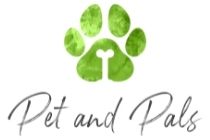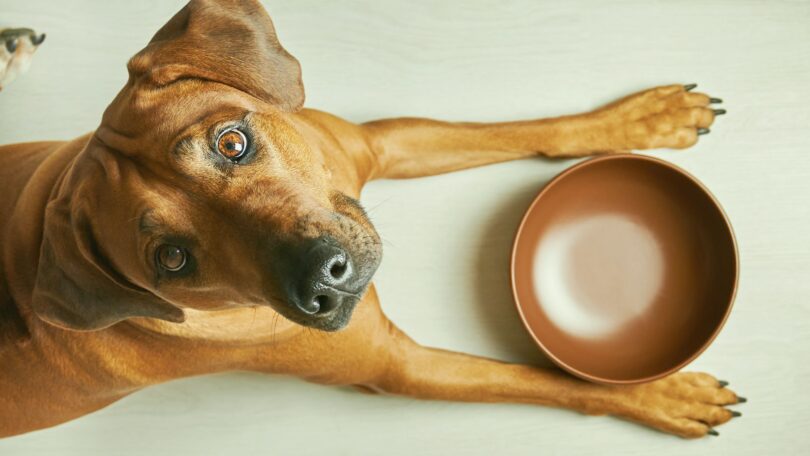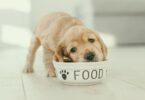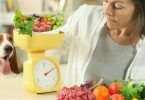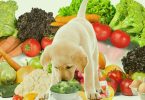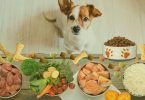Feeding a dog healthily is not always an easy task. Many questions arise and sometimes we don’t know where to look for the answers. Thinking about it, we created this list of 50 facts and questions about dog food.
We hope it can help you! ♥
1. How often to feed senior dogs?
Older and senior dogs, considered 8+ years old, should have their dietary regime adjusted to two meal-a-day feedings. Adjusting to feeding once in the morning and once in the evening will compliment a typically more sedentary and less energetic lifestyle.
According to Edgar&Cooper an adjustment in food can also be beneficial with a more nutritional diet to enforce joints and bone health. Adding natural food into their diet that is Omega 3 rich will help older dogs with not only stronger bones, joints and also strengthen their brains. Of course, always make sure there is plentiful fresh drinking water when feeding.
Source: vcahospitals.com
2. Why feeding your dog the correct amount of food is important?
It is important to feed your dog balanced proportions of food. Too little and they can have nutritional deficiencies, too much can lead to health issues with obesity. Among the obesity health issues are:
- Labored breathing
- Skin Disorders
- Congestive heart failure
- Shortened life span
- Cushing’s disease
Petmd guidelines promote providing the correct amount of high-quality natural food that supports your pet’s health overall and keeps them active and feeling good.
3. Should i feed my dog wet food or dry food?
It doesn’t matter as long as both food types provide the same correct nutrients. The decision may lay with your dog, what do they prefer, if both food types are the same nutritiously, go with the one your dog enjoys. Most pet owners provide dry dog food due to the convenience of storage, however, if a dog is sick or has a sore mouth, it is recommended to serve wet food to encourage eating and hydration.
4. My dog has bad breath, is that an indication i am feeding the wrong diet?
No, in all probability, the diet is not causing bad breath. Try using a dog toothbrush with dog toothpaste to freshen the breath. Typically, the most common cause of bad breath is a plaque buildup on the dog’s teeth. If the pet’s breath has changed suddenly with a strong odor may be a red flag and call for a visit to the vet.
5. Is it bad to sneak bites to your dog at the dinner table?
It is not a good idea to feed table scraps to your dog. The dog’s nutritious diet can be altered causing issues, and seemingly safe human foods can be dangerous for dogs. For example, avocados, chocolate, and some artificial sweeteners can cause major health problems for your pet. When in doubt make sure and make an effort to confirm your dinner table food is okay for your dog to eat.
6. Do dogs need a balanced nutritional diet?
Just like humans, dogs need a natural nutritionally balanced meal for good health. Natural dog food will contain a properly balanced meal with the nutrients required for a healthy life. It also has to have the taste, consistency, and palatability for the acceptance of your pet. It is important to set a regular feeding time, ideally around family breakfast or dinner time. When your pet begs for more, instead of feeding more food beyond what is required for good health, just ignore the dog’s coaxing or simply give hugs as an alternative.
7. What are some interesting things humans have fed to dogs?
Humans have fed dogs an amazing, and not a too healthy diet, an array of foods in the past. Dogs were fed what their human owners had on hand, many times not the most nutritious meal but could survive, often like the humans themselves had to eat. The foods on hand included hardtack, potatoes and cabbage, and horse meat.
Source: akc.org
8. What was hardtack and why fed to dogs?
Moldy hardtack biscuits (consisted of flour, water, and maybe salt) were thrown away by sailors in port cities on the docks and were eagerly eaten by dogs. Many entrepreneurs noticed the dog’s taste for hardtacks and began a quick, easy-to-distribute dog food, unfortunately, the dog food did not create a natural, balanced diet.
9. Why were potatoes and cabbage fed to dogs?
Royalty in medieval times fed their dogs a natural, balanced diet of vegetables, grains, and meats. However, the peasants could only feed their dogs the same food they consumed, which was primarily potatoes and boiled cabbage. Potatoes and grain are the main ingredients in many dog foods today but do not provide the natural balanced diet required for a healthy and balanced life.
10. Was horse meat fed to dogs often in the past?
In the mid-1800s a large number of horses were working in cities and provided a good available source of meat for dogs. Horse meat was abundant and being a cheap cut of meat, proved to be an excellent source of meat for dogs. Horse meat was prevalent in many popular dog food products until being banned in the United States in 1970.
11. Is It safe to feed a dog a homemade diet?
Any diet for a dog’s good health is dependent on the quality of the ingredients put into it. Oftentimes people may add cheap meat and scraps from the store to be frugal not realizing they are compromising the pet’s health. The meat purchased at the butcher may contain hormones, steroids, antibiotics, and other unhealthy additives. It should be noted that dogs are more omnivores than carnivores, and require a more natural balanced diet of carbohydrates and vegetables in addition to a diet of only meat.
12. Isa BARF (Bones and Raw Food) diet recommended?
Some argue that dogs in the past were fed raw meat and bones for their diet and survived. While there is some truth to that statement, it should be noted that ancestral dogs had only around a 5-year life, while today’s modern dogs live around 15 years. The big risk to dogs today is the spread of salmonella or E-coli from consuming raw meat. It may be the dog’s digestive system could handle radical salmonella or E-coli bacteria more efficiently in the past than today’s modern dogs. The risk of exposing your dog to these bacteria is not worth feeding your pet a BARF diet.
13. Why are essential nutrients important for your dog?
For your dog to remain healthy it is important to be fed a balanced diet. The recommended diet should include a mix of carbohydrates, proteins, fats, minerals, vitamins, and water. Make sure and look on the dog food container for “complete and balanced nutrition” on the label.
14. Why are fats important and what are they?
Your dog derives energy from fats and they greatly contribute to a dog’s healthy hair and skin. There are many important fatty acids including Omega-3, Omega-6, and Linoleic acid that a dog requires for a healthier life. Since a dog does not have the ability to make enough fats on its own, they must be included in your dog food.
15. Why are proteins important for your dog?
Proteins make the body tissues and a dog’s body only makes 13 or the 23 building blocks of proteins. The remaining 10 proteins have to come from a natural, balanced dog food diet. Make sure and verify your dog food has proteins incorporated into it.
16. What are carbohydrates and why are they important?
When your dog eats vegetables and grains in its diet it will receive many much-needed carbohydrates. A well-balanced, natural dog food provides the sugars, starches, fiber, and carbs to maintain the dog’s tissue and the healthy intestinal system required for your pet’s long life.
17. Why are minerals and vitamins important?
Minerals and Vitamins are necessary to maintain your pet’s strong bones and keeping your pet robust and strong. They are necessary for many of the chemical reactions in a dog’s body to assure proper growth and health. Balanced and natural dog food may contain many of the minerals and vitamins including:
- Vitamin A
- Vitamin D
- Vitamin E
- Vitamin K
- B-Complex Vitamins
- Phosphorous
- Calcium
18. What are dome dog food myths?
There are many myths on the internet about feeding dogs. Many myths go back years, passed along as the “truth” when they are well-meaning but misguided. There are many Urban Legends about feeding dogs on the internet but there are some truths behind the legends.
19. Is lamb really hypoallergenic?
Meat is inherently not less allergenic from one to another. When first introduced to dogs, it did appear to be less allergenic since it was new to a diet, however, as it became more mainstream it too created allergies in dogs.
20. Should we feed dogs pork?
It was once feared pork would lead to deterioration of a dog’s health due to too much fat or had toxic ingredients that might damage a dog’s liver. In fact, today’s pork is lean meat, easily digestible by most dogs with fewer allergies. Interestingly, there are few packaged pork dog food products, perhaps due to the fear of trichinosis or that most parts of a pig are processed for human consumption.
21. Can dogs eat cooked food?
Dogs have adapted over the millennia to eat food provided by their human companions, and that includes cooked food. Actually, it is easier for dogs today to digest foods that are highly complex carbs after being cooked. Dogs that are being fed raw diets may adversely affect not only their health but those in the home and especially the ones immunocompromised and young children.
22. Is it important to keep the dog’s food bowls clean?
Yes, and make sure to keep the dog’s bowl clean to maintain your pet’s health. Most of us would not considers eating out of the same soup bowl days apart without cleaning and your pet should not be treated any differently. Dirty food bowls for your dog encourages the growth of bacteria that can adversely affect your dog’s health from vomiting, upset stomach, and even diarrhea. Always clean your dog’s food bowls daily with soap and water to prevent any bacterial contamination.
23. Are there different nutritional requirements for different breeds of dogs?
It has been established that different breeds have some variations in nutrient requirements and metabolism. Dog breeds from the cold Arctic Circle may have different requirements from dog breeds from a water-centric environment. To optimize the dog’s health and ensure a long of a life as possible, it is important to take into consideration the individual dog’s species and respective individual nutrient requirements. Just as important is to consider your dog’s lifestyle, a house lap dog has different nutritional requirements than a dog that works in the field such as a retriever, herder, or a tracking dog.
24. Should i feed my dog food with the word “meal” in it?
It is important to know that dog food labeled with the words “beef meal” or “chicken meal” actually means it is “rendered meat”. Animal by-products are sent to rendering plants to process and may include blood, feathers, grease, or entire carcasses. When compared to natural, high quality dog food, there is a major difference in nutritional values.
25. Is dog nutrition important and how to provide it?
A natural, balanced diet is critical to your dog’s development and overall health. A high-quality, natural, and balanced dog food should provide all the nutrients necessary for a healthy and long life. There may be some adjustments made for your pet depending on the breed, age, any illnesses they may have at various stages of their life cycle. If your pet has a symptom of an illness, it is recommended to visit a veterinarian for any adjustments in your pet’s diet.
26. How should i feed and wean a puppy?
The person responsible for a puppy needs to move the puppy from feeding on a mom’s milk diet to regular natural puppy food. The process of “weaning” from mother’s milk to healthy puppy food typically begins around three to four weeks of age. Remember, puppies require twice the energy intake of an adult dog, so make sure the puppy is fed food that is 25%-30% protein. A cautionary note, it is easy to over-feed a puppy, make sure and allocate proper servings and not overfeed and lead to future health problems.
27. Should i be watchful of my dog’s weight?
Overfeeding your pet is one of the most common issues pet owners face. It is easy to lavish treats and big meals to our pets but is a misguided affection. Serious health problems may arise from overfeeding your dog including diabetes, heart disease, reduced lifespan, and arthritis. Make sure and keep a watchful eye for any issues that may pop up from your dog having too much food.
28. What are good adult dog feedings?
To maintain proper body tissue conditions, adult dogs need to acquire sufficient nutrients. The account of activity and size your dog may have can dictate the amount of food consumption. As activity levels vary greatly among pets so does the caloric intake and should be adjusted accordingly.
29. What are some foods never to feed your dog?
It is common knowledge by most folks that chocolate is bad for your pets, but there are many other foods to avoid. Some other items to avoid are macadamia nuts, grapes and raisins, onions, and even bones. It is advised to avoid bones as they can splinter and puncture a dog’s intestinal tract or can lodge in the throat and cause choking.
30. How do i know how to choose proper dog food?
The most common food fed to dogs is either kibble (nutritional dry pressed dog food usually in pellets) and wet canned dog food. They are manufactured to contain the necessary nutrients required for a dog’s good health. The nutritional requirements vary from dog species (large breed or small breed) and age (adult dogs or puppies) and to make certain the correct food is being served to your dog the Merck Veterinary Manual is an excellent reference guide.
31. Are dogs considered wolves?
Although dogs share around 98 percent DNA with wolves, they are different in their nutrition is not the same and do not require a raw diet. Many studies have found there is not any correlation between a raw diet or a mixed diet being more beneficial for a dog. In fact, a raw meat diet can introduce many harmful pathogens that could cause food poisoning for both the dog and human handler.
32. What are the different life stages of dogs?
The generally accepted guidelines for a dog life’s stages are:
Puppies – As a general rule, the puppy life stage is considered 4-6 weeks up to 9-24 months.
Adults – As a rule, the adult age is from the age of 1 to 6-8 years old.
Senior Dogs – Dogs are considered “senior dogs” from the ages 6-10 years old.
Pregnant or Nursing Dogs – This life stage does not have years assigned but should be noted as the nutritional feeding cycle should be appropriate for these conditions.
33. What are the different nutrient classifications for dogs?
There are six different nutrient classifications: vitamins, carbohydrates, fat, protein, water, and minerals. Vitamins, water, and minerals are necessary for proper body functioning and only fat, protein, and carbohydrates provide energy. The most important and necessary nutrient is fresh, clean water, ideally in multiple locations.
The AAFCO Nutrient Requirements for Dogs is an excellent reference guide for more detailed information.
34. Is meat more nutritious than meat meal?
Ounce for ounce, dog food meat meal typically has more protein content than meat alone. Ingredients of dog food are listed in order by descending weight, for example, chicken listed in the ingredients may mean unprocessed, so water is included in the weight factor. However, the processed chicken meal will have fat and water removed resulting in a higher percentage of protein by weight.
35. Does feeding raw eggs to your dog create a shiny coat?
This is an old myth that may be based on some facts, but any nutritious diet heavy on fats can also create shinier coats. In reality, no studies promote as a fact raw eggs create shiner coats than any other food high in fats. There is also the ongoing debate of raw eggs introducing salmonella, food authorities cautioning against it and dog naturalists advocating it.
36. Is natural food better for a dog?
the overall well-being of a dog is enhanced with a diet made from natural ingredients including beef, lamb, chicken, spinach, carrots, peas, and blueberries. Natural foods increase energy level, helps heart health, and improves shinier coats, better-smelling breath, and improved eyesight.
37. What should my dog be fed?
The first recommendation would be to check with your vet what would be best to feed your dog. All dogs are individuals, and your dog’s diet requirements may be entirely different from your friend’s dog feeding habits. It is acceptable to feed your dog a complete kibble diet and if desired to mix in some cooked or raw meat, fish, vegetables, or rice.
38. What are some considerations when selecting dog food?
Some considerations for selecting the correct dog food for your pet are:
- Health of your pet
- How active is your dog
- Does your dog have any food allergies
- Size and age of your dog
- Your dogs taste and smell for food
- How your lifestyle allows shopping and fixing meals for your dog
39. What foods for humans are safe for dogs?
Typically human food should not be fed to dogs, but some served as treats or with meals are dog palatable. Whole, natural unprocessed food low in salt, sugar, and fat in small portions as treats or okay if they do not make up more than 10 percent of the dog’s daily intake. Some healthy options to consider are:
- Carrots
- Turkey
- Chicken
- Beef
- Green Beans
- Sweet Potatoes
- Apples
- Peanut Butter
- Bananas
40. What are some foods to avoid feeding your dog?
Dogs love to eat and will eat about anything, but some foods should be avoided and may even be toxic. Foods to be avoided are:
- Onions
- Grapes/raisins
- Chocolate
- Alcoholic drinks/foods
- Caffeinated drinks/foods
- Macadamia nuts
- Yeast dough
- Fatty and salty foods
- Moldy or rotten food
- Bones, antlers, or animal hooves
41. What foods should i feed my diabetic dog?
The American Animal Hospital Association (AAHA)says the most important aspect of feeding a diabetic dog is consistency rather than content. The most important aspect of dog feeding is high-quality, natural, and balanced dog food. It is recommended to avoid simple sugars that are contained in syrups, white bread, and white rice among other foods. Often diabetic dogs can have pancreatitis and if so make sure to avoid foods with high-fat content.
42. Can the type of a dog dish affect a dog’s feeding?
Yes, if you see your dog cowering or being hesitant to eat, it could be the type of dog bowl being used. Some dogs, especially nervous or hesitant types, may be turned off or afraid of metal dog food bowls. If you see this behavior, swap to a different type or non-metallic bowl and see if that affects their feeding behaviors.
43. Is it okay when the dogs scoots the bowl across the floor?
Enthusiastic dog feeders may scoot a bowl when feeding across the floor and that usually is perfectly okay. Sometimes this happens a lot with wet food as it becomes stuck to the sides and the dog works hard to get that last bite or lick from the bowl.
44. What does it mean when my dog moves food to the floor?
Typically, dogs move food to the floor because the food bowl comes into play again. They may not like the smell of the bowl, or perhaps it has soap residue on it. It could be simply it slides around too much and makes weird sounds, moving food to the floor ensures a stable, quiet eating environment.
45. Why does my dog sometimes eat dirt?
We may see the dog chew on shoe leather, or maybe gnaw on a pillow, but eating dir, that seems weird. Actually, it may be your pet’s way to ingest some missing nutrients missing in its diet. Dirt often is a good source of zinc, iron, magnesium, and potassium. If your pet is eating dirt from the garden, it may be telling you its diet needs to be adjusted more nutrients.
46. Should i be concerned if my dog takes long time to eat?
While some dogs, such as Labs, may inhale their meal within seconds, other dogs take some time to finish their meal. Taking their time may not be such a concern, it could mean the dog is comfortable in its environment and is confident no other dog will eat ist food. However, it could also mean an infected tooth or stomach issues, make sure and keep an eye on your pet for any abrupt changes in their eating habits.
47. Should i feed my dog sweet treats?
When you sit down for a dessert or sweet treat, your pet is staring at you with a wagging tail and eyes that melt the heart. Unfortunately, not all sweet treats for humans are necessarily good for the dog. It is important to know what treats are good and the bad ones is an important consideration for your dogs continues good health.
48. What are some sweet treats that may cause a problem for dogs?
Always avoid any chocolate sweet treats or anything containing the sweetener Xylitol. Chocolate or Xylitol can cause abnormal heart rhythms, seizures, and maybe death. Feeding your pet Xylitol can increase insulting and could lead to liver damage. A reasonable amount of chocolate substitute carob chips can be given.
49. Is it okay to feed my dog peanut butter or yogurt?
Peanut Butter is a good natural sweet treat to stuff into one of your pet’s favorite toys. Besides providing hours of happy eating, it will also provide beneficial proteins and vitamins. Another special treat is plain yogurt, make sure and avoid yogurt with added sweets or flavorings. A great way to make your dog happy on a hot afternoon is to fill ice cube trays with yogurt and feed your pet frozen yogurt cubes.
50. Is it okay to feed fruit to my dog?
Fruits are another natural sweet-flavored treat to feed your dog. However, always make sure to avoid raisings and grapes, they have a toxic substance that can possibly lead to a dog’s kidney failure. The good news is, there are many fruits such as berries, bananas, apples, and watermelon that are not only a sweet treat but provide many beneficial vitamins with good fiber content.
We hope these dog feeding facts were beneficial, fun, and most importantly contribute to your pet having a long and healthy life!
